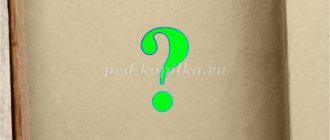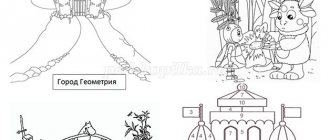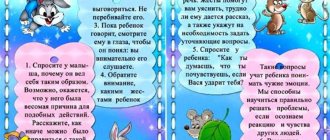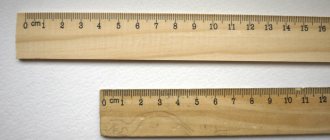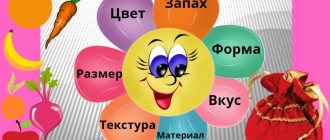Final GCD in mathematics in the preparatory group: Topic: “Flower - seven-colored”
Final GCD in mathematics in the preparatory group:
Topic: “Flower - seven-flowered”
Age group:
children of the preparatory group.
Target:
Exercise children in using mathematical knowledge in a gaming situation.
Educational objectives:
1. Improve skills in direct counting within 20, quantitative and ordinal counting, understanding counting and numbers up to 20.
2. Learn to correlate numbers with the number of objects, solve problems.
3. To consolidate knowledge about geometric shapes and the ability to create images of objects from geometric shapes, to navigate the plane of the sheet.
4. Find your bearings in the sequence of days of the week.
Developmental tasks
:
1. Develop attention, intelligence, and the ability to navigate in space.
2.Develop curiosity, mutual assistance, and independence.
Educational tasks:
1. Cultivate interest in mathematical knowledge; the ability to understand a learning task; the desire to help the heroes of the fairy tale; do good deeds for your comrades and loved ones; desire to show off your knowledge.
2. Foster a positive attitude towards learning activities.
Preliminary work
: Solving logical problems, working with geometric shapes, working with cards, reading V. Kataev’s fairy tale “The Flower of Seven Flowers.”
Material:
Cards with numbers for each child, a flower with seven petals, cards with geometric shapes for each child, 10 different toys, magnetic board, magnetic numbers, geometric shapes for each child, 7 pieces of bagels, a letter, cards - tickets with numbers from 1 to 10, a bag of treats.
Progress of activities:
Children stand near the teacher in a semicircle.
Educator: Guys, I want to invite you on a journey through a fairy tale, and which fairy tale we will go to, I will read in the letter that the storyteller sent us yesterday. Oh, but there is no letter, but instead of a letter, here is a piece of paper and the signature “Old Lady”; Let's see what's on the piece of paper - this is the plan according to which we need to find the letter. Can you children help me find the letter?
Children: Yes.
Children follow the route following the words (turn right, 2 steps forward, turn left, three steps forward, etc.)
The children find the letter.
The teacher reads: Today we will go to V. Kataev’s fairy tale “Flower - seven-colored flower. Once upon a time there lived a girl, Zhenya. Mom sent her to the store for bagels. The girl bought bagels.
Two for dad, two for mom, two for myself and one for my brother. How many lambs did Zhenya buy?
Children: 7 bagels
Educator: Let's check.
Children count the bagels that are on the table. (Children's answer.)
Educator: Correct.
Educator. But while Zhenya was walking home and looking at the store windows, the dog ate the bagels. The girl ran after the dog and did not catch up, but she met an old woman who gave the girl a magic flower. Look at the flower that lies on the table. What flower does it look like?
Final lesson in the preparatory group for FEMP “Looking for Simka”
Quest – game “Journey to the King of Mathematics”
Target:
creating favorable conditions for the formation of elementary mathematical concepts in preschoolers.
Tasks:
— to develop computing skills;
- exercise children in forward and backward counting within 10;
- fix shape, color, size.
- create conditions for the development of logical thinking, intelligence, attention;
-develop imagination, ingenuity, visual memory;
- contribute to the formation of mental operations, speech development, and the ability to argue one’s statements.
- cultivate interest in mathematical knowledge;
- develop the ability to understand a learning task and carry it out independently
What will we do, guys? Shall we pass all the tests? Then everyone come here and no matter what happens, let's swear.
Mathematical quest - game “In search of a mathematical suitcase” Goal: Development of an active, active position of the child in the process of solving game search problems. Objectives: educational involvement of each child in an active cognitive process; developing the development of interest, creativity, imagination of preschoolers, search activity, desire for novelty; educational development of tolerance, personal responsibility for doing work. Material and equipment: letter from Ivan Tsifrikov; sound recording with an address from Digital Eater; ladle; an envelope with a letter from Geometry Figurovny, 4 sets of geometric shapes of different sizes and 4 primary colors made of felt and 4 “pans” felt frames; “broken” clock and fallen felt numbers in an envelope; flash card, TV, laptop, slide presentation; soft wire basket; feltgraph with houses of Tsifrograd residents, cards with examples and padlocks instead of answers, an arrow and an envelope with funny numbers; a cylinder with 4 split puzzles and a note from Digital Eater; balloons and a sign with an encrypted word; footprints; math suitcase. Progress of the lesson: Q: Guys, I received a letter this morning. I wonder who sent it to us? Let's read it. “Dear guys, Professor Ivan Tsifrikov writes to you. I live in a wonderful place and am engaged in various mathematical sciences. I heard that you really love doing math, so I decided to send you a wonderful suitcase with a variety of games and math tutorials. Practice, develop and remember me! Digital City and the city
The suitcase should be delivered to you on Thursday, April 20th. Wait." Q: Guys, how lucky we are! We received such a wonderful letter, and a package is also expected. We'll wait... So, wait... (draws the children's attention to the board on which today's date and month are written). What day of the week is it today? What date is today? D: Thursday. 20 April! Q: Today is Thursday, April 20th! The parcel was supposed to arrive today. But the postman brought me only one letter and nothing more. Strange. Maybe he brought the parcel to the group, but simply forgot to tell me about it. Let's look for her. The teacher and the children go to look for the package in the group. At this time, a sound recording is turned on, which attracts the children and teacher C: “Hey, you kids! You don't have to look for anything! I am the Digital Eater, the most dangerous villain in the mathematical land. I hid your math suitcase in a safe place, and now you will never find it, and I sent the best residents of Digital City to your kindergarten. And now I will rule the city! And you will never find your suitcase, unless there are clues that I accidentally dropped when I was confusing my tracks Hahaha.” The recording is turned off. Q: Wow! Guys, did you hear what Digital Eater said? D: Yes! That he left clues. Q: You and I need to find these clue items, find all the inhabitants of Digital City, get to the villains and get back the mathematical suitcase. Not an easy task! Are you ready to deal with it? D: Yes! Q: Then, we need to find the very object that will help us start our search. This item may be very ordinary, but what must be unusual is that this item should not be here. Children go to look for an object. They find a ladle. Q: It seems we have found the first clue. What is this, guys? D: Ladle. Q: The most common ladle, but should it be in a group? D: No! Q: Where should it be? Where is his place? D: In the cupboard with dishes. Vera Parfenovna pours soup into their plates. Q: Then let's go to the cupboard and try to find the next clue there. The children and the teacher go to the closet. There they see a letter. Q: I wonder what is written there? (In the envelope is a letter with a picture of a man made of geometric shapes in the form of a cook)
